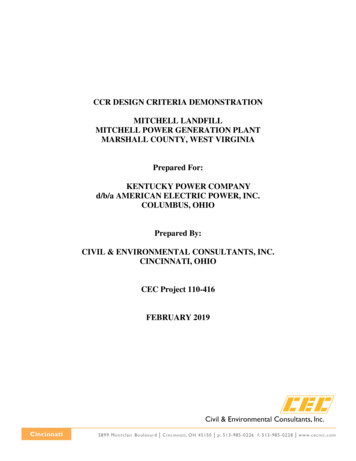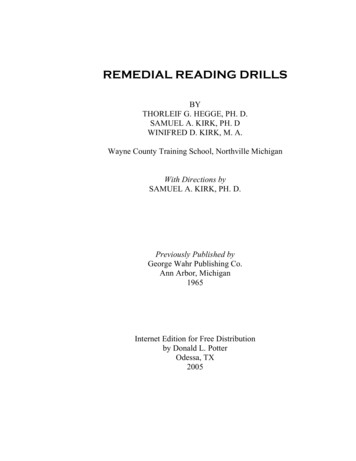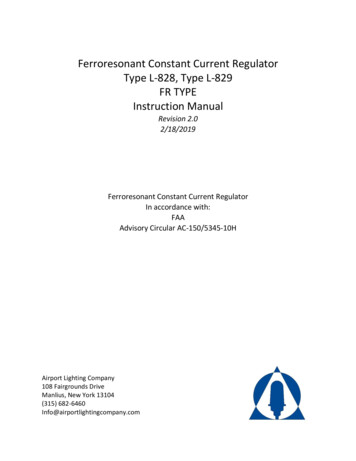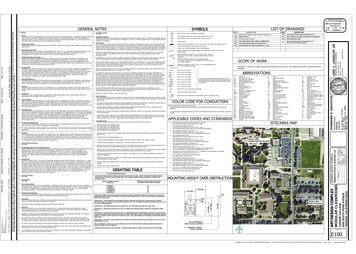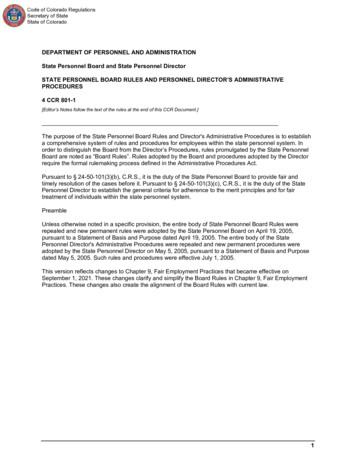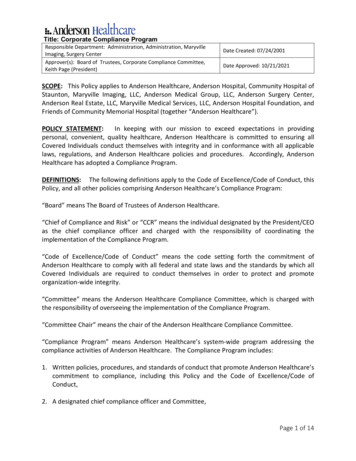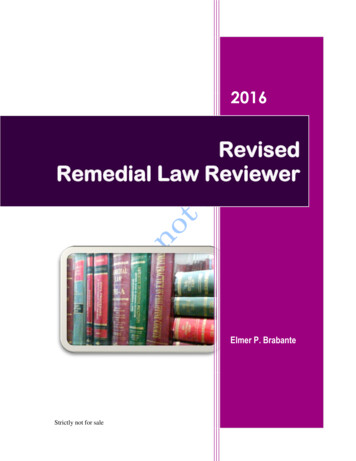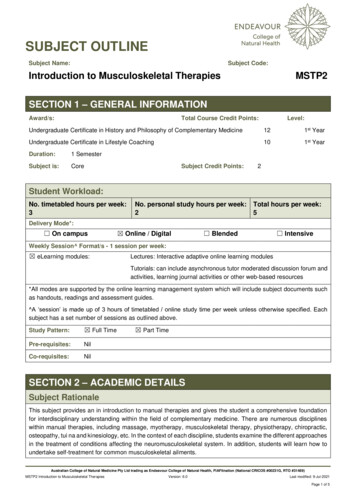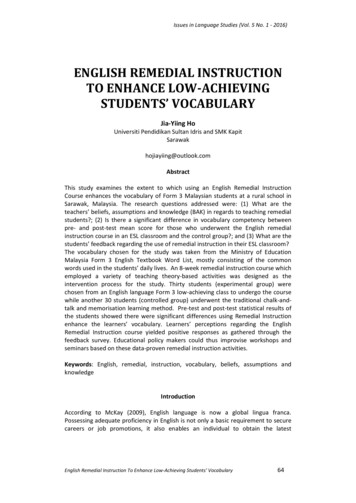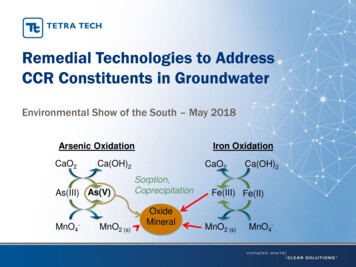
Transcription
Remedial Technologies to AddressCCR Constituents in GroundwaterEnvironmental Show of the South – May 2018Arsenic OxidationCaO2Ca(OH)2As(III) As(V)MnO4-CCR Rule Groundwater Compliance StrategyIron OxidationMnO2 Fe(III) Fe(II)MnO2 (s)MnO4-
Agenda Topics to be Covered Overview of CCR Rule Groundwater Monitoring Program and Timeline– Baseline Monitoring– Detection Monitoring– Assessment Monitoring Corrective Measures Assessment Selection of Remedy Remediation and TimelineCCR Rule Groundwater Compliance Strategy2
CCR Rule Groundwater MonitoringProgram OverviewCCR Rule Groundwater Compliance Strategy3
Initial (Baseline) Monitoring Minimum of 8independent samples perwell or spring required(background/upgradientand downgradient) Analyze for all AppendixIII and Appendix IVparametersAppendix IIIAppendix ium 226 228SulfateChromiumSeleniumTotal Dissolved SolidsCobaltThalliumFluoride Sufficient number ofsamples obtained andanalyzed for all four CCRunitsCCR Rule Groundwater Compliance Strategy4
Statistical Analysis of Data Goals of Statistical Analysis: Determine if statistically significantincrease (SSI) greater than backgroundconcentrations for each Appendix IIIparameter for Detection Monitoring Determine if statistically significantlevel (SSL) greater than MCL oralternative criteria concentrations foreach Appendix IV parameter forAssessment Monitoring Determine if Appendix IV parameters indowngradient wells have been belowMCL or alternate criteria for 3consecutive years after CorrectiveAction Measures implementedAppendix IIIAppendix ium 226 228SulfateChromiumSeleniumTotal Dissolved SolidsCobaltThalliumFluoride Statistical Analysis is DynamicCCR Rule Groundwater Compliance Strategy5
General Characteristics of Sites Located near rivers or other major water bodies Selection of upgradient and downgradient monitoring welllocations Sites located on Karst with selection of springs asmonitoring locations Existing water treatment systemsCCR Rule Groundwater Compliance Strategy6
Next Steps in CCR ComplianceTimeline CCR Rule Overview Next steps in CCRCompliance TimelineOCT 20171st Round of DetectionMonitoring (DM) Sampling– Error AnalysisDEC 2017Complete Lab Analysis,Data Validation, andStatistical AnalysisApp III SSI DeterminationError, Natural GroundwaterQuality Variation (NGQV), orAlternate SourceDemonstration (ASD)– Natural Groundwater QualityVariationMAR 2018First Round of AssessmentMonitoring (AM) Sampling(All App IV)Complete Lab Analysis andData ValidationDevelop GroundwaterProtection Standards(GWPS) for Detected App IVJUN 20182nd Round of AM Sampling(All App III / Detected AppIV)Complete Lab Analysis,Data Validation, andStatistical AnalysisSEP 2018App IV SSL DeterminationError, NGQV, or ASD Detection Monitoring– Alternate Source Determination Assessment MonitoringDEC 2018– Same as Above What is UnknownCCR Rule Groundwater Compliance Strategy7
Detection MonitoringAppendix IIIAppendix ium 226 228SulfateChromiumSeleniumTotal Dissolved SolidsCobaltThalliumFluoride Minimum semi-annual (2x year) monitoring for Appendix IIIDEC 2017Complete Lab Analysis,Data Validation, andStatistical AnalysisApp III SSIDeterminationCCR Rule Groundwater Compliance StrategyError, NaturalGroundwater QualityVariation (NGQV), orAlternate SourceDemonstration (ASD)MAR 20188
Assessment Monitoring-BaselineDataAppendix IIIAppendix ium 226 228SulfateChromiumSeleniumTotal Dissolved SolidsCobaltThallium If Appendix III SSI’s are confirmed (no errors,natural groundwater variation, or alternatesources), initiate Assessment MonitoringFluorideCCR Rule Groundwater Compliance StrategyMAR 2018First Round of AssessmentMonitoring (AM) Sampling(All App IV)Complete Lab Analysis andData ValidationJUN 20182nd Round of AM Sampling(All App III / Detected AppIV)Complete Lab Analysis,Data Validation, andStatistical AnalysisSEP 2018App IV SSL DeterminationError, NGQV, or ASDDevelop GroundwaterProtection Standards(GWPS) for Detected App IVDEC 20189
Assessment Monitoring-BaselineData Initially analyze for App IV and establishGroundwater Protection Standards (GWPS)for each App IV constituent GWPS Maximum Contaminant Level(MCL) if one exists, or backgroundconcentration, whichever is higher Within 90 days, resample for App IVconstituents that were previously detectedplus App III list If Appendix IV constituents are detected at aStatistically Significant Level (SSL) GWPS,must characterize the nature and extent ofthe release Within 90 days, initiate assessment ofcorrective measuresAppendix IIIAppendix ium 226 228SulfateChromiumSeleniumTotal Dissolved SolidsCobaltThalliumFluoride If SSL GWPS for an unlinedimpoundment, cease receipt of CCR andinitiate closure within 6 months (Ash PondJune 2019)CCR Rule Groundwater Compliance Strategy10
Corrective Measures Assessment &Selection of Remedy3rd Round of AM Sampling (All App III andDetected App IV)DEC 2018Initiate Nature and Extent of ReleaseCharacterizationMAR 2019 (MAY2019)Complete Assessment of CorrectiveMeasuresJUN 2019 (AUG2019)Selection of RemedyPublic MeetingOngoing AM SamplingAs Soon asFeasibleImplement Corrective Action Plan (CAP)1st Round of Corrective Action (CA)SamplingOngoing AM Sampling90 DaysOngoing CA SamplingOngoing AM SamplingCompletion of CAPCCR Rule Groundwater Compliance StrategyInitiate Assessment of CorrectiveMeasures2020 and Beyond11
Corrective Measures Assessment &Selection of Remedy Corrective MeasuresAssessment Goals: Prevent further releases Remediate any releases Restore affected area tooriginal conditions Step 1 – Collect and EvaluateAdditional Data (RemedialInvestigation/RFI) Define nature and extent ofcontamination– Additional monitoring wells, dyetraces– Additional sampling for broad suiteof analytes– Update the conceptual site model– Geology– Hydrogeology– Geochemistry– Data to support analysis of remedialalternativesCCR Rule Groundwater Compliance Strategy12
Corrective Measures Assessment &Selection of Remedy Step 2 – Evaluate a Range ofCorrective Measures (FeasibilityStudy/CMS) Final adjustments to preferredapproach Schedule for design andimplementation– Select feasible remedial approach– Addresses the contaminants– Implementable– Cost-effective Step 3 – Select preferredapproach (Proposed Plan)– Detailed analysis of selectedapproach– Regulator approval– Public meetingCCR Rule Groundwater Compliance StrategyStep 4 – Finalize preferredapproach (Record ofDecision/Statement of Basis)Step 5 – Detailed design(Remedial Action WorkPlan/Design) Possible Pre-design data collection Define performance evaluationcriteria Step 6 – Design Implementation(Remedial Action/CMI) Remedy construction/installation Remedy operation and maintenance13
Corrective Measures Assessment &Selection of Remedy Options Pump and Treat (existing water treatment systems) Monitored Natural Attenuation (MNA) In-Situ Treatments (i.e., Sorption/Precipitation) Permeable Reactive Barriers Cut-Off Walls (in combinations)CCR Rule Groundwater Compliance Strategy14
MNA – Application to Inorganics Inorganic MNA applicable to theAppendix IV metalsMNA relies on physicaland chemical processesin the aquifer to addressmobile contaminantMNA as a remedynormally requires: Source control Detailed conceptualmodel to predictbehavior Long-term monitoringwith periodic updates ofthe conceptual modelCCR Rule Groundwater Compliance Strategy-Privileged and Confidential Attorney Work ProductCCR Rule Groundwater Compliance StrategySource: ITRC2010Remedial Options15
MNA and Appendix IV Inorganics Data to evaluateTier 1:Plume Stable or ShrinkingTier II:Identification of AttenuationMechanismsTier III:Attenuation Ability and CapacityTier IV:Long Term M&MMNA ascorrective actioncollected as partof investigationto define natureand extent ofcontaminationRemedial OptionsCCR Rule Groundwater Compliance Strategy16
Manipulate Aquifer Geochemistry Arsenic OxidationCaO2Ca(OH)2As(III) As(V)MnO4Iron Oxidation-MnO2 Fe(III) Fe(II)MnO2 (s)MnO4Approach: Oxidize As (III)to As(V), Increase sorptivecapacity Oxidants under study:Permanganate, Calcium Peroxide Manganese oxides: Increasesorptive capacity Ferrous sulfate oxidation:Increase sorptive capacity- Calcium peroxide: pH buffer oniron hydrolysisRemedial OptionsCCR Rule Groundwater Compliance Strategy17
Manipulate Aquifer Geochemistry Can you manipulate theaquifer to precipitateAppendix IV metals fromgroundwater? Metal phosphates,sulfates, sulfides andhydroxides can beinsolubleAppendix x10-222.53x10-331x10-27ChromiumCobaltLead Aquifer chemistry may bemanipulated to precipitatemetals (e.g., modificationof in situ halliumHydroxide1.6x10-93Arsenic Permeable reactive barrierdesign could incorporatesources of anionsCCR Rule Groundwater Compliance ionic18
Permeable Reactive Barrier Reactive media in thePRB tailored to thecontaminants ofconcern, e.g.,ConventionalPRB Alumina to adsorb As Apatite (phosphate) toprecipitate lithium Iron filings to sorb arsenicand molybdenumoxyanions Sulfate source toprecipitate radiumCCR Rule Groundwater Compliance StrategySource: USEPARemedial Options19
Field Design of Packed BedBafflesDirectionof flowPackingFlow events above design flow willbypass over the treatment areaCapped Drain Pipe with Filter FabricSock covering for sampling and feedingRock Cover LayerLinerExaggerated SlopeFlow will beforced intoand throughtreatmentarea bybafflesSource: US Army Corps of Engineers, Engineer Researchand Development Center – Patent Pending
Pilot Scale ImplementationCCR Rule Groundwater Compliance Strategy
Sampling and Data Logging UnitRain GaugeSamplecollection anddata loggerSolar panel
Permeable Reactive BarrierInstallation Long Stick Excavation Slurry Trench Bench Setting One-Pass TrencherRemedial OptionsCCR Rule Groundwater Compliance Strategy23
In Situ Bioreactors Engineeredsubsurfacemechanism tocontrol thegroundwaterchemistry Provides an initial “jolt”to the system Mechanism forrecharging the feedsystem Biotic or abiotic actionscan be stimulatedCCR Rule Groundwater Compliance Strategy24
Case Study I – In Situ BioreactorsCCR Rule Groundwater Compliance Strategy25
Summary and Questions Sites often present physical limitation on remedialapproaches (e.g., proximity to rivers) Sites often have extensive experience with conventionalwater treatment systems – pump and treat may be anattractive option CCR-related metals can be addressed with conventionalremedial approaches CCR-related metals may be amenable to innovative in situapproaches QuestionsCCR Rule Groundwater Compliance Strategy26
CCR Rule Groundwater Compliance Strategy 24 . Case Study I - In Situ Bioreactors CCR Rule Groundwater Compliance Strategy 25 . Summary and Questions . Title: CCR Rule GW Remediation and Compliance Strategy Author: Rick Arnseth Created Date: 5/31/2018 8:18:10 AM .
